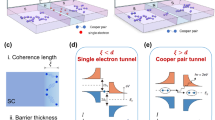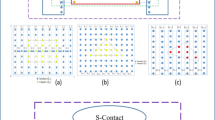The transparency coefficients of a semiconductor structure consisting of alternating asymmetric potential barriers and wells, where the Bastard condition is taken into account, are calculated. It is shown that in the structure, an oscillation of the transmission coefficient of electrons depending on their energy is observed, which is caused by the interference of the de Broglie waves coming to the barrier and reflected from the potential barrier. The electronic states of a multilayer semiconductor structure consisting of alternating potential wells and barriers are analyzed.
Similar content being viewed by others
References
A. A. Shchuka, Nanoelectronics [in Russian], Fizmatkniga, Moscow (2007).
G. M. Mladenov, V. M. Spivak, E. G. Koleva, and A. V. Bogdan, Nanoelectronics. Introduction to Nanoelectronic Technology [in Russian], Tekhnosfera, Kiev, Sofia (2009).
D. A. Usanov and A. V. Skripal’, Physical Foundations of Nanoelectronics [in Russian], Saratov (2013).
V. P. Dragunov, Foundations of Nanoelectronics [in Russian], Fizmatkniga, Moscow (2006).
G. Bastard, Wave Mechanics Applied to Semiconductor Heterostructure, Editions de Physique, Les Ulis., France (1988).
E. L. Ivchenko and G. E. Pikus, Superlattices and Other Heterostructures: Symmetry and Optical Phenomena, Springer Series in Solid-State Sciences, Heidelberg: Springer Verlag, Berlin (1995); second edition (1997).
I. V. Belyaev, E. I. Golant, and A. B. Pashkovskii, Fiz. Tekh. Poluprovodn., 31, No. 2, 137–144 (1997).
E. I. Golant, and A. B. Pashkovskii, Fiz. Tekh. Poluprovodn., 31, No. 9, 1077–1082 (1997).
E. I. Golant, and A. B. Pashkovskii, Fiz. Tekh. Poluprovodn., 34, No. 2, 334–339 (2000).
E. I. Golant, and A. B. Pashkovskii, Fiz. Tekh. Poluprovodn., 36, No. 3, 330–337 (2002).
A. B. Pashkovskii, Pis’ma Zh. Eksp. Teor. Fiz., 82, Nos. 3–4, 228–233 (2005).
V. F. Elesin, Zh. Eksp. Teor. Fiz., 121, No. 4, 925–932 (2002).
V. F. Elesin, Zh. Eksp. Teor. Fiz., 123, No. 5, 1096–1105 (2003).
V. F. Elesin, Zh. Eksp. Teor. Fiz., 124, No. 2 (8), 379–393 (2003).
V. F. Elesin and I. Yu. Kateev, Fiz. Tekh. Poluprovodn., 42, 586–590 (2008).
V. F. Elesin, Zh. Eksp. Teor. Fiz., 145, No. 6, 1078–1086 (2014).
V. I. Galiev, A. N. Kruglov, A. F. Polupanov, et al., Fiz. Tekh. Poluprovodn., 36, No. 5 , 576–581 (2002).
J. N. Davies, The Physics of Low-Dimensional Semiconductors, Cambridge University (1998).
Author information
Authors and Affiliations
Corresponding author
Additional information
Translated from Izvestiya Vysshikh Uchebnykh Zavedenii, Fizika, No. 4, pp. 8–15, April, 2020.
Rights and permissions
About this article
Cite this article
Rasulov, R.Y., Rasulov, V.R., Mamadalieva, N.Z. et al. Subbarrier and Overbarrier Electron Transfer through Multilayer Semiconductor Structures. Russ Phys J 63, 537–546 (2020). https://doi.org/10.1007/s11182-020-02067-7
Received:
Revised:
Published:
Issue Date:
DOI: https://doi.org/10.1007/s11182-020-02067-7




